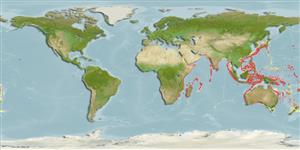Environment: milieu / climate zone / depth range / distribution range
Ecologie
marien benthopelagisch; diepte 180 - 550 m (Ref. 9834), usually 300 - 450 m (Ref. 9834). Tropical
Indo-West Pacific: probably widely distribtuted in tropical and warm-temperate waters of the Indian Ocean (excluding the Red Sea) and from Japan to eastern Australia.
Grootte / Gewicht / Leeftijd
Maturity: Lm ? range ? - ? cm
Max length : 21.0 cm SL mannelijk / geslacht onbekend; (Ref. 54802); common length : 15.0 cm SL mannelijk / geslacht onbekend; (Ref. 9834); max. gepubliceerd gewicht: 110.00 g (Ref. 54802)
Dorsale stekels (totaal) : 11 - 13; Dorsale zachte stralen (totaal) : 17 - 21; Anale stekels: 2 - 3; Anale zachte stralen: 17 - 20; Wervels: 31 - 32. Light to dark brown, fins dark; eye blue; young with dark band near base of tail (Ref. 4412). Body moderately elongate and compressed. Ventral profile very convex. Caudal peduncle moderately deep, compressed, lacking scutes or keels. Snout blunt, forehead slightly arched. Mouth small, terminal or slightly inferior, barely reaching beyond anterior margin of eye. Upper jaw not protractile, almost totally covered by lacrimal (preorbital) bone when mouth closed. Eye large , its diameter subequal to snout length, slightly smaller than interorbit, centered on upper half of head. Low ridge extending over eye. Jaw teeth small, in a single series. Palatine teeth more elongate, in single row. Vomerine tooth patch small. Single median row of teeth on tongue (Ref 9834).
Found near continental and insular margins (Ref. 9834), in deep water on continental slopes (Ref. 30573). Adults are characterized by a demersal mode of life in the upper continental slope, between 180 and 800 m (commonly 300-450 m) and the young are found in mid-water layers (Ref. 54802). Feeds mainly on salps (Ref. 33689). Marketed fresh and could also be used as fishmeal or paste (Ref. 9502).
Levenscyclus en paargedrag
Maturities | Voortplanting | Spawnings | Egg(s) | Fecundities | Larven
Haedrich, R.L., 1986. Nomeidae. p. 846-850. In M.M. Smith and P.C. Heemstra (eds.) Smiths' sea fishes. Springer-Verlag, Berlin. (Ref. 4412)
Status op de Rode Lijst van het IUCN (Ref. 130435)
Gevaar voor de mens
Harmless
Gebruik door de mens
Visserij: van potentieel belang
Tools
Speciale rapporten
Download XML
Internetbronnen
Estimates based on models
Preferred temperature (Ref.
123201): 8.8 - 15.4, mean 11.1 °C (based on 249 cells).
Fylogenetische diversiteitsindex (Ref.
82804): PD
50 = 0.5010 [Uniqueness, from 0.5 = low to 2.0 = high].
Bayesian length-weight: a=0.00977 (0.00420 - 0.02273), b=3.09 (2.88 - 3.30), in cm total length, based on LWR estimates for this (Sub)family-body shape (Ref.
93245).
Trofisch niveau (Ref.
69278): 3.5 ±0.0 se; based on diet studies.
Weerstandsvermogen (Ref.
120179): Hoog, minimale populatieverdubbelingstijd minder dan 15 maanden (Preliminary K or Fecundity.).
Fishing Vulnerability (Ref.
59153): Low vulnerability (16 of 100).
